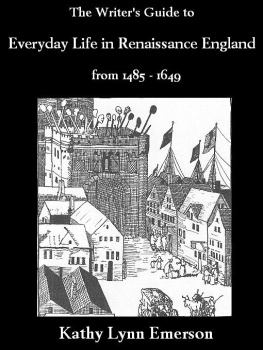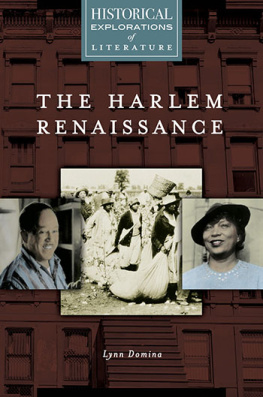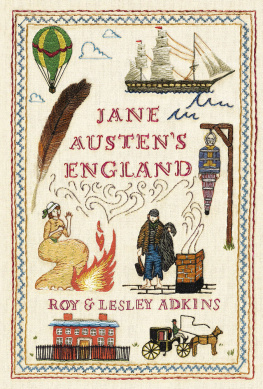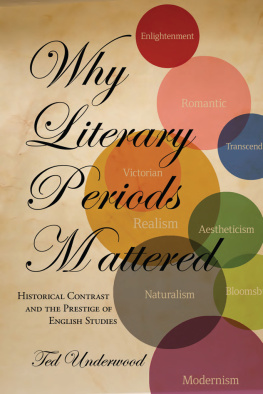The Writers Guide to Everyday Life in Renaissance England
from 1485-1649
Revised and Expanded Edition
Kathy Lynn Emerson
Table of Contents
INTRODUCTION
PART ONE: EVERYDAY LIFE
ONE CLOTHES AND ACCESSORIES
Men's Clothing; Women's Clothing; Outerwear; Children's Dress; Country Dress; Hair, Beards, and Cosmetics; Assorted Accessories; Items of Clothing; Fabrics of the Renaissance
TWO FOOD AND DRINK
On the Menu; Table Settings and Manners; Preservation of Food; Health Problems and Diet; Foods; Alehouses; Drinks
THREE ARCHITECTURE
Manor Houses and Mansions; The Italian Influence on English Architecture; Building Materials; Royal Residences; Prodigy Houses; Specialized Rooms; Ornamental Gardens; Orchards; Native and New: Flowers and Fruits
FOUR FURNISHING A HOUSE
Items of Furniture; Coverings for Floors, Walls, and Ceilings; Lighting; Sanitation and Bathing Habits; Music and Music Rooms; Libraries and Collectors
FIVE MARRIAGE AND FAMILY
Birth; Marriage; Death; Extended Family
SIX PHYSIC AND PHYSICIANS
Practitioners; Women in Medicine; Hospitals; The Plague; Healing Waters; Ailments; Medicines; Herbal Cures; Magical Stones
PART TWO: GOVERNMENT AND WAR
SEVEN GOVERNMENT
The Privy Council; Departments of Central Government; Parliament; Local (County) Government; Population; Treason; Conspiracies and Rebellions
EIGHT MONARCHS, NOBLES, AND COMMONERS
The Succession; The Court; The Peerage; The Gentry; The Trade of CourtiershipSome Notable Women
NINE CRIME AND PUNISHMENT
Lawyers; Steps in the Legal Process; Central Law Courts; Assizes; Quarter Sessions; Prerogative Courts; A Miscellany of Specialized Courts; Law Enforcement Personnel; Prosecution of Criminals; Punishments; Tudor and Stuart Gun ControlA Summary of Laws; A Sampling of Cases
TEN COINS, MONEY & HOW MUCH THINGS COST
Minting of Coins; Domestic Coins; Foreign Coins in Use in England; Sources of Royal Revenue; Inflation; Wages and Prices; Usury; Imprisonment for Debt; Shopping Malls
ELEVEN WAR AND PEACE
Embassies; The Pale of Calais; The Invasion of France in War; The Invasion of France in PeaceThe Field of Cloth-of-Gold; The Royal Navy; The English Army in Ireland; Heads of State; Significant Events
TWELVE A SEAFARING NATION
Life at Sea; Common Sizes of English Vessels; Mariners Superstitions; Flags; Merchant Ships; Fishing Fleets; Pirates and Privateers; Passenger Ships; Definitions; Significant Seafaring Events
PART THREE: RENAISSANCE SOCIETY
THIRTEEN EDUCATION, SECULAR AND RELIGIOUS
Literacy; Penmanship; Schools; Higher Education; Religious Education; Religious "Parties"
FOURTEEN EMPLOYMENT
Domestic Servants; The Statute of Laborers and Artificers; Guilds; Women in Trades; Apprentices; Workers without Guilds; The Tobacco Trade; Mining; Manufacturing; Unemployment; Illegal Professions
FIFTEEN ENTERTAINMENT
Fairs; Festivals; Professional Entertainment; Reading as Entertainment; Sports and Recreations
SIXTEEN LANGUAGE
Languages of England; Grammar and Usage; The Flavor of the Language; Language used in Letters; Given Names; Forms of Address; Common Slang Terms; Color Names of the Renaissance
SEVENTEEN LIFE IN LONDON AND OTHER CITIES
A Miscellany of London; The Housing Boom; Urban Problems; A Sampling of Urban Centers
EIGHTEEN RURAL LIFE
Crops; Enclosure; Livestock; Manors and Farms; Towns and Villages; Deer Parks and Royal Forests; Antiquities; Gypsies
NINETEEN TRAVEL AND TRAVELERS
Travel by Land; Travel by Water; Postal Service; Inns; Royal Progresses; Foreign Travel
TWENTY WITCHES, MAGIC, NECROMANCY & SUPERSTITION
Witches; Magic; Necromancy; Astrology; General Belief in the Supernatural
APPENDIX GENERAL BIBLIOGRAPHY
Books that cover a number of areas; select bibliographies are at the end of each chapter
INTRODUCTION
The Renaissance began in Italy, flowered in France and slowly made its way to England. In the year 1500, Henry VII was on the throne of England. His son, the future Henry VIII, was receiving the education that would make him one of the great Renaissance Princes of Europe. For the purposes of this volume, then, Renaissance England refers to the reigns of Henry VII (1485-1509), Henry VIII (1509-1547), Edward VI (1547-1553), Mary I (1553-1558), Elizabeth I (l558-1603), James I (1603-1625), and Charles I (1625-1649), and the period comes to an abrupt end with the execution of King Charles.
It is impossible to do justice to a century and a half in a single book, but The Writers Guide to Everyday Life in Renaissance England offers two services to writers of historical romance, historical mystery, time travel, and other historical fiction. First, it gives starting points in the form of introductions to a number of specific subject areas. Second, it indicates which of the many volumes of social, economic, literary, and political history are most likely to provide the sort of information novelists need. It is to be hoped that othersstudents writing papers, reenactors, and those who simply love reading about the pastwill also find this volume useful.
In-depth studies have been done on exceedingly narrow subjects. Many of their authors, however, were more interested in presenting statistical data or proving some obscure thesis than in supplying interesting anecdotal material. All of the books listed in my select bibliographies are available through interlibrary loans. Most were published during the last thirty years. Ive tried to reflect the most recent research while avoiding radical interpretations (although I have included, annotated, a few of the more interesting ones). Lost documents are always coming to light and older records are constantly being reexamined. Therefore, assume that all statistics are approximate and that almost any fact can and will be debated by scholars.
In addition to the select bibliographies in each chapter, this volume contains time lines, quick reference lists and sidebars to aid in finding specific details. The chapters are arranged by broad subject areas. Material which falls into more than one category is cross-referenced in the text.
A NOTE ON THE REVISED EDITION
This revised and expanded edition includes some links to websites. They are accurate as of November 2004. In general I do not advise relying only on the Internet for research, since so much of what is there is undocumented and anonymous, but it is an excellent source of visual examples of material discussed in this text.
A NOTE ON DATES AND TIME
The seasons were different in the sixteenth and seventeenth centuries, starting several weeks earlier than they do now in North America. Spring began in February, summer in May, autumn in August, and winter in November.
Dates can seem confusing for other reasons as well. In 1582, in order to ensure that church holidays occurred in the proper seasons, Pope Gregory XIII issued a decree dropping ten days from the calendar. By 1583, Italy, Portugal, Spain, France, and the Roman Catholic German States were all using New Style dates. England, however, as a Protestant nation, continued to use the Old Style Julian Calendar until 1752. Thus, English reports on the Spanish Armada of 1588 record events as taking place ten days earlier than Spanish reports do. The day of the week also differed. May 1, 1593, for example, was a Tuesday in the Julian calendar but a Saturday in the Gregorian calendar.
In England, the new year began on Lady Day, March 25, although the holiday called New Years Day, on which gifts were presented to the monarch, was already being celebrated on January 1. Thus you may find dates for events which took place between January 1 and March 24 written with the so-called double dating, for example February 23, 1588/9. Leap years, as now, added a February 29th every four years; 1584 was a leap year. Law and university terms continued to be fixed by the church calendar even after the ReformationHilary Term (beginning in January), Easter Term (beginning after Easter), Trinity Term (beginning after Whitsunday), and Michaelmas Term (beginning in October).





